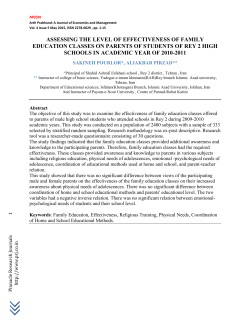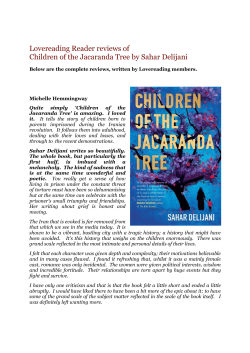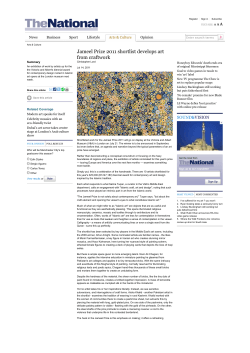
S Y L
ISLAMIC REPUBLIC OF IRAN Fourth Asia Pacific Ministerial Conference on Housing and Urban Development Regional Slum Upgrading Working Group SUPPORTING YOUTH LIVELIHOODS EXECUTIVE SUMMARY Urban Development and Revitalization Organization (UDRO) Secretariat for Regional Slum Upgrading Working Group, APMCHUD Majid Kianpoor Deputy Minister and Executive Director, UDRO Majid Roosta Director General, National Task Force for Informal Settlements Upgrading, and Secretary, Regional Slum Upgrading Working Group, APMCHUD Mohammad Saeed Izadi,PhD Assistant Professor, Avicenna University & Secretary, UDRO Peer review Committee Babak Pirouz Adviser, Regional Slum Upgrading Working Group, APMCHUD Niloofar Mosleh Expert, Regional Slum Upgrading Working Group, APMCHUD Sommayeh Farhadi Expert, Regional Slum Upgrading Working Group, APMCHUD UDRO Peer Review Committee Pooya Alaeedini, PhD Assistant Professor, University of Tehran Alireza Esmaeilzadeh, PhD Resident Representative, UN-Habitat, Iran Mohammad Ayeeni Board Member, UDRO Mozaffar Sarrafi, PhD Assistant Professor, Shahid Beheshti University Nasser Bonyadi, PhD Assistant Professor, Architecture and Urban Planning Research and Studies Centre Esfandiar Zebardast, PhD Deputy for Research, Faculty of Fine Arts, University of Tehran Hamid Majedi, PhD Associate Professor, Islamic Islamic Azad University Azita Rajabi, PhD Associate Professor, Islamic Azad University Rahim Sarvar Associate Professor, Rey Islamic Azad University Guiti Etemad President of Board, Tarh va Memari Consultants Mojtaba Rafiian Professor, Tarbiat Modarres University Ali Farzin, PhD Chief, Poverty Alleviation and Economic Development Section, UNDP, Iran Navid Rezvani Qazvin Islamic Azad University Nasser Mashadizadeh Executive Director, Ivan Naqsh Jahan Consultants Farhad Gholizadeh Secretary, National Committee for Slum Upgrading Peer Review Committee was assisted by Nazanin Ghaffari PhD Candidate, Islamic Azad University Saber Mohammadpoor PhD Candidate, Shahid Beheshti (National) University Drafted by Farzin Fardanesh, PhD Assistant Professor, Shahid Beheshti (National) University Contents Introduction: the ‘Youth Bulge’ in Iran ........................... 5 Youth in Iran.................................................................. 5 Threats and Opportunities............................................. 6 Legal Environment ........................................................ 7 Higher Youth Council .....................................................7 National Task Force for Management of Youth Affairs ...8 Ministry of Sports and Youth ..........................................9 Youth Voluntary Activities in Iran ................................ 10 Ministry of Education ....................................................10 Red Crescent Society...................................................12 Police Force .................................................................12 Youth and Upgrading .................................................. 13 Municipality of Tehran ..................................................13 Urban Development and Revitalization Organization.... 14 3 In the Name of God LIVELIHOOD OPPORTUNITIES FOR YOUTH Introduction: the ‘Youth Bulge’ in Iran A prominent demographic feature of Middle East is the ‘youth bulge’: about 65 per cent of the region’s population is under the age of 30. Islamic Republic of Iran is no exception. In 2011, the youth (15~29 age group) comprised 31% of the total population of the country with this percentage increasing as high as 35.3% in provinces with larger rural population. Figure 1 Population Pyramids in 2011-Youth population (15~29 age group) highlighted Youth in Iran Iranian youth enjoy a relatively high and increasing literacy rate. In 2006, for example the literacy rate for male and female youth has been 97% and 95%, respectively. The same trend could be seen in higher education enrolments: in 2006, the total youth enrolment in higher education was 5 ISLAMIC REPUBLIC OF IRAN about 13%, while the female enrolment rate has increased from 9.2% in 1996 to 12.6% in 2006. Despite this increase in education levels, youth employment has decreased in the past decade. Employment is lower for females than male youth population. In 2006, about 81% of male youth were employed, while the employment level for females was about 62%. Iran witnesses significant population mobility in its provinces. More than 55% of migration is within the province. Nevertheless, the reasons of migration for male youth are diversified; search for employment, compulsory military service and pursuit of education are among the key reasons for the female youth however, the major reason has been to accompany their family. Threats and Opportunities The young people living in slums face several callenges: lack of basic services; lack of employment opportunities; stigma and social exclusion; non-inclusive environment; lack of entertainment; fear of harassment and crime; vehicular traffic; inadequate waste management; and a sense of political powerlessness. Nevertheless, youth are valuable assets for now and future who are not only part of the core problem, but also, as vectors of development and change, constitute the solution. 6 LIVELIHOOD OPPORTUNITIES FOR YOUTH Legal Environment Youth affairs were the subject of concern since the Third Five Year Development Plan (2000~2005) under which a National Youth Organization was established. In accordance with article 112 of the Fourth Five Year Development Plan (2005~2009) a National Youth Document was elaborated and adopted by the Cabinet in 2005. Fully titled as the National Special Multi-Sectoral Development Document for Managing Youth Affairs, this document includes a comprehensive inter-agency plan for attending to youth affairs in the areas of: employment; housing; education and training; marriage; recreation; as well as national and religious identity. To assist implementation, an institutional arrangement is also defined at ministerial, sub-ministerial and provincial levels. The implementation of the National Youth Document is enforced in article 41 of the Fifth Five Year Development Plan (2010~2015). Higher Youth Council The Higher Youth Council is established in accordance with the National Youth Document. Headed by the President and attended by 22 members including: Minsters of Education; Science, Information and Technology; Islamic Guidance; Labour and Social Affairs; Health, Care and Medical Education; Interior; and Sports and Youth Affairs; as well as two Vice-Ministers; President 7 ISLAMIC REPUBLIC OF IRAN of Red Crescent Society; Islamic Azad University; Executive Director of Islamic Republic of Iran Broadcasting (IRIB), Commander of Militia Forces; and other relevant authorities, the Council oversees and coordinates activities of diverse agencies to: Assist development of youth personality based on ideals of Islamic Revolution; Respond to intellectual, social, physical, spiritual needs of the youth; and Pave the ground for Youth participation in social, cultural, economic and administrative aspects of the country. Provincial Youth Councils are established at provincial level to oversee the implementation of the National Youth Document at this level. National Task Force for Management of Youth Affairs Established as the executive arm of the Higher Youth Council and attended by authorized representatives of key relevant ministries, public organizations, universities as well as the representative of a youth NGO and five university professors, the National Task Force for Management of Youth Affairs makes operational decisions for implementation of the National Youth Document Action Plans. 8 LIVELIHOOD OPPORTUNITIES FOR YOUTH Ministry of Sports and Youth Ministry of Sports and Youth was formed by merging the National Youth Organization and the Physical Training Organization. It hosts the secretariat for the Higher Youth Council. The Minister of Sports and Youth is the president of the National Task Force for Management of Youth Affairs. The Ministry undertakes planning for marriage and family affairs, youth education and cultural affairs, as well as elaborating national plans concerning youth social participation. Figure 2 Organizational Chart of Ministry of Sports and Youth: deputies dealing with Youth are expanded. 9 ISLAMIC REPUBLIC OF IRAN Youth Voluntary Activities in Iran Different agencies have developed their own special programmes for organizing youth voluntary activities and promote their participation. Some of these programmes are implemented by one agency, while others are implemented as joint activities. Ministry of Education Ministry of Education has developed several schemes for organizing youth voluntary activities and promote their participation. Students Councils were first established in 1998 to prepare students for democratic participation. These elected councils act as advisors to the director of school, contribute to all curricular and extracurricular activities and will run school’s journal. This council will elect a representative to attend the Parents and Teachers Board. Figure 3 Students Council Elections (source: Iran News Agency) 10 LIVELIHOOD OPPORTUNITIES FOR YOUTH Students Parliament is elected by students form a list of school councillors for a period of two years. The parliament includes members from key religious minorities. The 150 elected members are formally appointed as advisers to the Minister of Education and as part of their mandate, review the bills of the Ministry before presentation to the national Parliament (Majles). Figure 4 the first meeting of Students Parliament (source: Iran Students News Agency) School Mayor is a joint activity with the Municipality, in which the Mayor, his deputies and members of City Council are elected by the students. The projects indentified by this City Council are then implemented by the Mayor, his deputies and voluntary support of the students with the financial support of the Municipality. 11 ISLAMIC REPUBLIC OF IRAN Red Crescent Society The Red Crescent Youth Organization is established under the Red Crescent Society to train young people. The trainees will then assist volunteer groups in disasters. Figure 5 members of the Red Crescent Youth Organization (source: Fars News Agency) Police Force The police provide several services targeting the young people such as counselling, training, virtual training, research, and supporting the making of movies. To encourage youth participation, the police organize conferences and seminars. Police Assistants are young people who volunteer to assist the police in improving the safety and security of their settlement. Figure 6 Young Police Assistants (source: IRP, Social Deputy) 12 LIVELIHOOD OPPORTUNITIES FOR YOUTH Youth and Upgrading There is a growing emphasis on the role of youth in upgrading of informal settlements in Iran. This trend could be seen both in the efforts of Tehran Municipality and UDRO. Municipality of Tehran The Municipality of Tehran has developed diverse programmes for organizing youth voluntary activities and promote their participation in settlement management. Figure 7 A weblog prepared by youth in Ahangrarn Neighbourhood Shahryaran Javan (Young City Assistants) is a network of young people who act as advisers to the District Mayors. Upgrading Offices are established by the Tehran Urban Renewal Organization in neighbourhoods to be upgraded. They act as facilitators who liaise with the community to initiate the upgrading process. Youth play a key role in this initiation phase. They are trained as journalists and webloggers who write on the history, identity and problems of their neighbourhood. This social network formed of interested youth then acts an agent of change and a strong advocator for upgrading. 13 ISLAMIC REPUBLIC OF IRAN Urban Development and Revitalization Organization (UDRO) Founded under the Ministry of Housing and Urban Development in 1996, UDRO’s projects were initially focused on deteriorated historic fabrics. Since 1999, UDRO has undertaken upgrading projects in informal settlements. Currently, UDRO has completed some 71 upgrading projects by investing IRI 537,000 billion and has 67 ongoing projects in 18 provinces in 50 informal settlements with a total investment of IRI 229,000 billion. UDRO has also implemented 63 catalytic projects to stimulate development in deteriorated fabrics. In these fabrics, UDRO has replaced more than 192,000 dilapidated buildings with 661,000 newly built houses. In upgrading projects, UDRO provides livelihood training in basic working skills, handicraft production and other income generating activities for the inhabitants. Training courses provided in informal settlements also targets youth for prevention of high risk behaviours such as drugs and HIV-AIDS. Figure 8 Rehabilitation of a square in Tabriz City 14 LIVELIHOOD OPPORTUNITIES FOR YOUTH Upgrading projects usually begin with focus group discussions with inhabitants of an informal settlement for needs assessment. Faith-based community organizations are effective entry points for initiating these discussions and building interest and trust. In this needs assessment exercise, the special needs of women and youth are duly considered. The focus group discussions lead to formation of self-help groups who identify local income-generating activities. UDRO supports these community-based organizations and assists the expansion of their activities to include neighbourhood weblogs and/or journals, formation of thematic community-based groups, creation of micro-credit fund. Thus a strong social network is developed which will guarantee meaningful participation and will subsequently lead the upgrading process. Figure 9 Faith-based community organizations are effective entry points for youth involvement and initiating the upgrading process 15 Regional Slum Upgrading Working Group P O Box 19395-4339, Tehran, I R Iran http://www.rsuwg.ir Email: secretariat@rsuwg.ir
© Copyright 2025





















